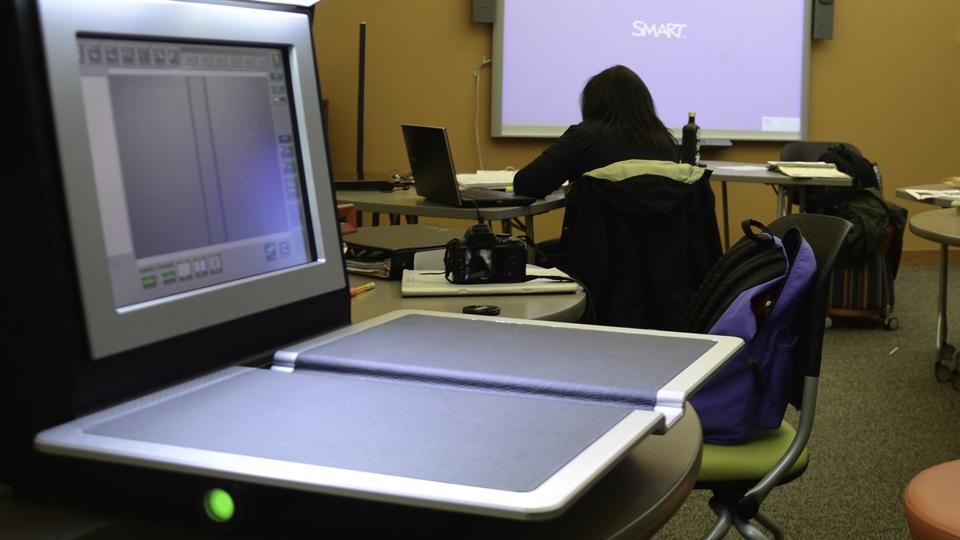The Hazel McCallion Academic Learning Centre is not just a place to borrow books and study. For example, students can sign out netbooks and laptops with administrative privileges. They can use these privileges to install software, such as course-related packages.
Here are some other library services that students and faculty can take advantage of.
The T-Room
The T-Room is next to the library’s help desk on level two (the ground floor). The room houses touch technologies, including the only Smart Board (a brand of interactive whiteboard) on campus, a touchscreen computer, and a Microsoft Perceptive Pixel workstation. The T-Room’s technologies also include a Microsoft Pixel Sense table, but the touchscreen table currently sits outside the room across from the main help desk (near the reference and research area).
The Smart Board, touchscreen computer, and touch table all run Microsoft Windows 7.
Students are absolutely allowed to come in and use this stuff,” says Rochelle Mazar, HMALC’s emerging technologies librarian. “When you are sitting at a computer, it is an individual experience. […] And yet we very often want students to work collaboratively.”
Mazar points out that group projects are easier to do on a larger multi-touch screen than on a desktop computer, as multiple users can engage with the technology.
The “T” in T-Room stands for “touch, try, teach, and technology”, according to Susan Senese, the associate librarian of research and information technology services.
“On CNN, when they start to do a story, they’re in front of their large interactive board, and they’ll pull up a satellite image and a photograph and a spreadsheet, and then create a story. That’s a Perceptive Pixel [workstation],” says Senese. “The whole idea was to foster creativity and innovation in students and faculty and expose [them] to new and emerging technologies.”
The library also plans to engage students, on either a volunteer or a paid basis, to develop applications for the technologies in the T-Room.
“One of the ideas that we have in our academic plan is to create a version of something they have downtown. It’s called ‘Thing Tank’. One of the ideas behind it is ‘critical making’, and it’s working with students to create new technologies,” says Ian Whyte, the deputy chief librarian and associate librarian of teaching and learning. “And in the process of designing and creating new technologies, there’s a lot of learning going on. That’s the essence of the T-Room: to create experiential learning opportunities through emerging technologies.”
The library plans to hold more workshops on the technologies, and to bring Apple Store-style iPad stations for students to use in the room as well.
Social media
Over the past year, the library has engaged students through social media platforms like Twitter, YouTube, Facebook, and Tumblr.
The library’s Facebook page has information updates, but the library more often uses Twitter
(@UTMlibrary) to announce updates and engage students, according to Eva Stepanian, the social media librarian.
Stepanian talked about the #UTMsoundcheck Twitter hashtag. “[The] idea is that if you’re in a silent zone and it’s noisy, you tweet ‘#UTMsoundcheck level 4 silent zone’, or ‘#UTMsoundcheck’ [and] wherever you might be, and whichever library staff is accessible would swing by the area,” she said.
During busy times of the year and exams, Stepanian also walks around the library and tweets about study spots that become available.
Students can also ask questions about research over Twitter, and the reply is broadcasted to all the library’s Twitter followers. Stepanian, who frequently helps students in the reference and research section, also tweets frequently asked questions about specific projects and course assignments.
The library’s YouTube channel (/utmlibrary101) has videos to help students with library services and academic topics, including videos on citations and peer-reviewing, how to loan books from other U of T libraries, and how to find books by subject in the library.
Stepanian also manages “Nonsense Catalogue of the UTM Library”, a Tumblr account on which she posts and reposts all kinds of light-hearted student-related media. The microblog is meant to be a stress-buster for students, says
Stepanian.
Reference and research
The reference and research area, located across from the main help desk on level two, provides students with help on how to find sources, use Microsoft Office tools like Excel and PowerPoint, and get started on assignments. The research help desk also provides tips on how to research efficiently and answers students’ research-related questions. However, the research and reference staff is also ready to help with questions not related to research.
“I would say it is one of the most important areas. What do we do? We answer questions. And there is no limit to the questions that can be asked. A lot of it is about research,” says Whyte. He emphasizes that library staff is always present to help students get started in the right direction and navigate library resources.
“We have conversations with students in third and fourth year. Every year we talk to students who say, ‘I wish I knew about this in first or second year.’ ” Whyte says the library staff can help students save a lot of time and anxiety—especially in the early years.



